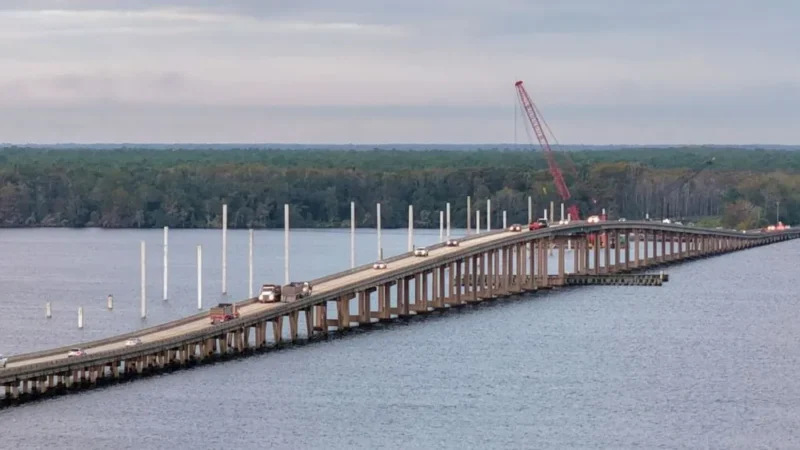The death of a sperm whale off the Venice coast this morning, while difficult even for marine experts who deal with such things, could be a learning experience for them.
“Every time you see a whale in distress, like we did yesterday, it’s always really hard. It’s really hard. And so all we can do is utilize the opportunity to learn as much about them as we can,” Laura Ingleby, chief of NOAA’s Marine Mammal branch, said Monday morning, standing on the beach near the whale’s carcass. “And then that helps us understand some of the things that we can do to ultimately recover and help them. And so, in that way, that’s how we have to think about it. ”
Ingleby said that while the whale’s death was a sad outcome, “we’ll do our best to learn as much as we can in the process. It’s always sad. And so it is an opportunity. As sad as it is. Our objective is to maximize it into learning as much so we can turn that back into making, you know, into ways to conserve and recover them in the future.”
Jessica Powell, with NOAA Fisheries Southeast Regional Office in St. Petersburg, confirmed that the whale had been stranded on a sandbar off Venice Beach and died in the early morning hours of Monday.
“Unfortunately the animal passed,” she said. “Right now the teams are mustering. The idea is to pull the animal onto the beach, which, you can imagine takes a lot of logistics, a lot of heavy equipment. This is a very large animal. We’re estimating around 60,000 pounds.”
The animal was seen stuck in the waves and sand Sunday morning. Venice Police Department, Sarasota County Sheriff’s Office, Florida Fish & Wildlife Commission and Mote Marine Laboratory were unsuccessful in rescuing the whale due to heavy winds and surf.
Powell said the whale would have a necropsy performed on it after it is brought to the beach.
“We take a lot of samples, which in general can help us understand more about sperm whales and hopefully help us learn more so we can help do a better job conserving these animals. It helps us understand why the animal was sick,” she said. “It will help us understand more about sperm whales … help us do a better job of understanding these animals,” Powell said.
Ingleby said sperm whales are an endangered species but are also resident animals to the Gulf of Mexico.
“So they are endangered. They’re deep divers. They typically feed thousands of feet beneath the surface on squid and giant squid and smaller squid,” she said. “They’re deep sea creatures. And we we know a little bit about them. But at the same time, they’re so far offshore, we don’t really get to see them.”
Ingleby said as much information as possible will be gleaned from the necropsy.
“That helps us learn about not just this individual, but about sperm whales in general. We know a little bit about them, but there’s always more to learn,” she said.
“One thing we do know, just by looking at the whale is it’s thin. So that tells us the whale probably hasn’t eaten in quite some time. And that’s never a good sign, right? And so for an animal to be this close to shore means it was not feeling great, and it wasn’t doing well. And so we’ll do what we can to understand why. And hopefully we’ll we’ll learn a little bit more in the process.”
She said the team involved in the assessment of the whale will begin taking measurements and photographs and getting as much data as they can.
“And then doing a necropsy so that we can try to get a better understanding of what happened, which we may or may not learn right away,” Ingleby said. “Sometimes it’s obvious. This whale is quite thin. Sometimes it’s less obvious. And we need to send samples out for analysis and wait for that to come back to understand what may have happened. And sometimes we never know, when every situation we learned something, and we learn about not just this whale but we learned about sperms in general. And so while sad … we’ll do our best to learn as much as we can in the process.”
It is also rare for such animals to wash up on Florida shores, Ingleby said.
“The last one, I remember that I was personally at, was 2008 near Madeira, I think. And so we get about two sperm whales that strand a year in the southeast U.S. that includes the Gulf and Atlantic,” she said. “And it’s been a while since a whale stranded in this area. So it is very rare. Well, it’s somewhat rare to have such a deep-water species that lives way out in the deep off of Mexico and up on the beach like this. And that definitely tells you it wasn’t doing so well.”
Lead image: A 50-foot-long sperm whale that was stranded on a sandbar off a Venice beach has died. State wildlife and local law enforcement officials remained at the Service Club Park beach area Monday, March 11, 2024. | Andrea Melendez, WGCU
9(MDEwNzczMDA2MDEzNTg3ODA1MTAzZjYxNg004))







